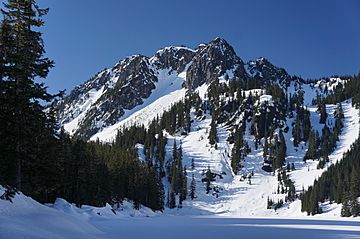Surprise Mountain facts for kids
Quick facts for kids Surprise Mountain |
|
|---|---|

Surprise Mountain, above Glacier Lake
|
|
| Highest point | |
| Elevation | 6,330 ft (1,930 m) |
| Prominence | 530 ft (160 m) |
| Isolation | 0.54 mi (0.87 km) |
| Parent peak | Thunder Mountain (6,556 ft) |
| Geography | |
| Location | King County Washington state, U.S. |
| Parent range | North Wenatchee Mountains Cascade Range |
| Topo map | USGS Scenic |
| Climbing | |
| Easiest route | Hiking |
Surprise Mountain is a tall mountain in Washington state, standing at 6,330 feet (1,929 meters) high. It is located above Glacier Lake in eastern King County. This mountain is part of the Wenatchee Mountains, which are a smaller group within the larger Cascade Range.
Surprise Mountain is found inside the Alpine Lakes Wilderness area. This land is managed by the Mount Baker-Snoqualmie National Forest. Water from rain and melting snow flows off the mountain into Surprise Creek and Deception Creek. These creeks then join the Skykomish River.
The closest taller mountain is Thunder Mountain, about 0.88 miles (1.42 km) to the northeast. Terrace Mountain is about 3 miles (4.8 km) to the southwest. The famous Pacific Crest Trail, a long hiking path, goes near Surprise Mountain through a spot called Surprise Gap.
Understanding the Climate of Surprise Mountain
Surprise Mountain is in a "marine west coast" climate zone. This means it gets a lot of influence from the ocean. Most weather systems start over the Pacific Ocean. They then travel northeast towards the Cascade Mountains.
As these weather systems reach the mountains, the peaks force the air upwards. This makes the air cool down and drop its moisture. This moisture falls as rain or snow onto the Cascades. This process is called "orographic lift." Because of this, the western side of the Cascades gets a lot of rain and snow, especially in winter.
During winter, the weather is often cloudy. But in summer, high-pressure systems over the Pacific Ocean bring clear skies. This means there is often little or no cloud cover. Because the ocean affects the weather, the snow tends to be wet and heavy. This can create a risk of avalanches. The best time to visit or climb Surprise Mountain is usually from July to September.
How Surprise Mountain Was Formed
The Alpine Lakes Wilderness has very rugged land. You can see sharp peaks, long ridges, deep valleys carved by glaciers, and tall granite walls. There are also more than 700 mountain lakes. Many years ago, big geological events created this varied land and the huge changes in height across the Cascade Range. These events also led to the different climates.
The Cascade Mountains began forming millions of years ago. This was during a time called the late Eocene Epoch. The North American Plate (a huge piece of Earth's crust) was moving over the Pacific Plate. This caused a lot of volcanic activity. Also, small pieces of the Earth's crust, called "terranes," joined together. This helped create the North Cascades about 50 million years ago.
Over two million years ago, during the Pleistocene period, glaciers repeatedly moved across the land. They carved and shaped the landscape. The last time glaciers melted away from the Alpine Lakes area was about 14,000 years ago. By 10,000 years ago, they had moved north of the Canada–US border. The river valleys in the area have a "U" shape. This shape was created by these recent glaciers.
The main forces that created the tall peaks and deep valleys of the Alpine Lakes Wilderness are "uplift" (when land pushes up) and "faulting" (when cracks form in the Earth's crust). These forces worked together with the glaciers to shape the land we see today.



